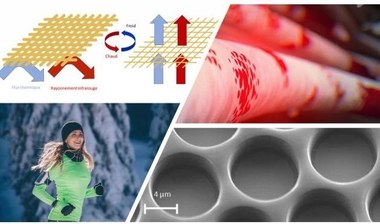PHOTONITEX - Development of microstructured textiles for stimuli-dynamic photonic filters
The goal of the PHOTONITEX project is to develop a new type of intelligent textile that will improve individual thermal comfort in an active way. These innovative garments will be able to adjust the infrared radiation reaching the human body as a function of the conditions of use: temperature (body or external) and humidity (perspiration).
Today, textiles exist that can redirect infrared radiation to the human body to ensure better thermal comfort. However, these solutions remain passive and they do not adapt to their environment. Therefore, the objective of the PHOTONITEX project is to produce active textile materials (membranes, filaments) that are able to adjust their infrared reflectivity depending on the temperature and/or humidity level in order to achieve a better thermal comfort. This feature is not only for athletes, it also covers personal protection, insulation, military engineering and interior textiles. To achieve this goal, inspiration is taken from natural photonic structures. In the PHOTONITEX project, analogous structures are generated adapted to the infrared light using methods compatible with the textile industry.
A multidisciplinary approach is needed for the design of these textiles and the evaluation of their performance. Therefore, specialists in optical modelling, composite materials and spinning techniques used in the field of textiles are part of the cross-border consortium: MateriaNova (leader), Ghent University, University of Mons, CETI, ENSAIT, University of Lille, HEI-Junia and EuraMaterials.
The role of Ghent University is to formulate and produce nanofibers from stimuli-responsive polymers. These polymers respond to external stimuli, such as pH, temperature or light and then exhibit a transition in their physical/chemical properties. Via electrospinning thermo-responsive nanofibrous membranes are produced combining the unique properties of nanofibers with the switching behaviour of the thermo-responsive polymers. These thermo-responsive nanofibrous membranes are further functionalised to tune their IR reflectance in order to achieve the project goal.
Further information
Website: www.photonitex.eu
Acknowledgements
This project is a part of the research by Jozefien Geltmeyer.
Funded by Interreg, the Photonitex project involves 8 partners in Flanders, Wallonia and France: Materia Nova (Wallonia), Ghent University (Flanders), CETI (France), EuraMaterials (France), ENSAIT (France), HEI-YNCREA (France), UMONS (Wallonia), Université de Lille (France). The project was coordinated by Materia Nova and took 4 years. Ghent University started its involvement in July 2018. The project ended in September 2022.
Contact
Prof. dr. ir. Karen De Clerck (Karen.DeClerck@UGent.be)

